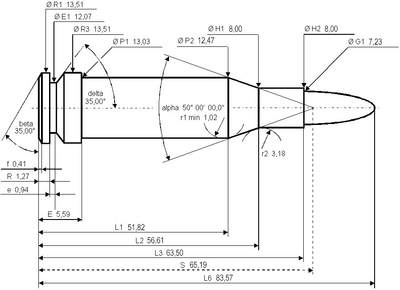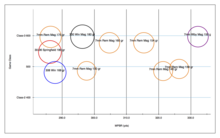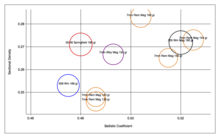
The .357 SIG is a bottlenecked rimless centerfire handgun cartridge developed by the Swiss-German firearms manufacturer SIG Sauer, in cooperation with ammunition manufacturer Federal Premium. The cartridge is used by a number of law enforcement agencies.

The .357 Smith & Wesson Magnum, .357 S&W Magnum, .357 Magnum, or 9×33mmR is a smokeless powder cartridge with a 0.357 in (9.07 mm) bullet diameter. It was created by Elmer Keith, Phillip B. Sharpe, and Douglas B. Wesson of firearm manufacturers Smith & Wesson and Winchester. The .357 Magnum cartridge is notable for its highly effective terminal ballistics.

The .338 Lapua Magnum is a rimless, bottlenecked, centerfire rifle cartridge. It was developed during the 1980s as a high-powered, long-range cartridge for military snipers. Due to its use in the War in Afghanistan and the Iraq War, the cartridge has become widely available.

The .308 Winchester is a smokeless powder rimless bottlenecked rifle cartridge widely used for hunting, target shooting, police, military, and personal protection applications globally. It is similar, but not identical, to the 7.62×51mm NATO cartridge.

The 7mm-08 Remington is a rifle cartridge that is almost a direct copy of a wildcat cartridge developed around 1958 known as the 7mm/308. As these names would suggest, it is the .308 Winchester case necked down to accept 7 mm (.284) bullets with a small increase in case length. Of cartridges based upon the .308, it is the second most popular behind only the .243 Winchester. However, the .308 is more popular than both. In 1980, the Remington Arms company popularized the cartridge by applying its own name and offering it as a chambering for their Model 788 and Model 700 rifles, along with a limited-run series within their Model 7600 pump-action rifles during the early 2000s.
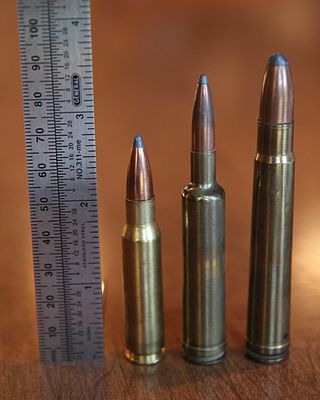
The .257 Weatherby Magnum is a .257 caliber (6.53 mm) belted bottlenecked cartridge. It is one of the original standard length magnums developed by shortening the .375 H&H Magnum case to approx. 2.5 in (64 mm). Of the cartridges developed by Roy Weatherby, the .257 Weatherby Magnum was known to have been his favorite, and the cartridge currently ranks third in Weatherby cartridge sales, after the .30-378 Weatherby Magnum and the .300 Weatherby Magnum.

The .375 H&H Magnum, also known as .375 Holland & Holland Magnum, is a medium-bore rifle cartridge introduced in 1912 by London based gunmaker Holland & Holland. The .375 H&H cartridge featured a belt to ensure the correct headspace, which otherwise might be unreliable, given the narrow shoulder of the cartridge case. The cartridge was designed to use cordite which was made in long strands – hence the tapered shape of the case, which, as a beneficial side effect also helped in smooth chambering and extraction from a rifle's breech.
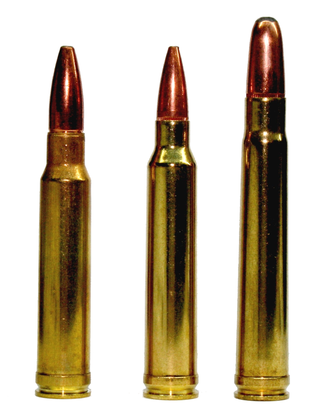
The .300 Winchester Magnum is a belted, bottlenecked magnum rifle cartridge that was introduced by the Winchester Repeating Arms Company in 1963. The .300 Winchester Magnum is a magnum cartridge designed to fit in a standard rifle action. It is based on the .375 H&H Magnum, which has been blown out, shortened, and necked down to accept a .30 caliber (7.62 mm) bullet.

The .338 Winchester Magnum is a .338 in (8.6 mm) caliber, belted, rimless, bottlenecked cartridge introduced in 1958 by Winchester Repeating Arms. It is based on the blown-out, shortened .375 H&H Magnum. The .338 in (8.6 mm) is the caliber at which medium-bore cartridges are considered to begin. The .338 Winchester Magnum is the first choice among professional brown bear guides in Alaska to back up clients where a powerful stopping caliber is required on charging bears. It is also the most popular medium-bore cartridge in North America and has the most widely available choice in rifles among medium bore rifles. The action length is the same as a .30-06, and most major rifle manufacturers in the United States chamber rifles for the cartridge including the semi-automatic Browning BAR Mk II Safari, making it a very powerful combination against charging dangerous game. The cartridge was intended for larger North American big-game species and has found use as for the hunting of thin-skinned African plains-game species.

The 8mm Remington Magnum belted rifle cartridge was introduced by Remington Arms Company in 1978 as a new chambering for the model 700 BDL rifle. The 8mm Remington Magnum's parent case is the .375 H&H Magnum. It is a very long and powerful cartridge that cannot be used in standard length actions, such as those that accommodate the .30-06 Springfield.

The 8×68mm S rebated rim bottlenecked centerfire rifle cartridge was developed in the 1930s by August Schüler of the August Schüler Waffenfabrik, Suhl, Germany as a magnum hunting cartridge that would just fit and function in standard-sized Mauser 98 bolt-action rifles. The bore has the same lands and grooves diameters as the German 7.92×57mm Mauser service cartridge. This is one of the early examples where a completely new rifle cartridge was developed by a gunsmith to fit a specific popular and widespread type of rifle.
The .264 Winchester Magnum is a belted, bottlenecked rifle cartridge. Except for the .244 H&H Magnum and .257 Weatherby Magnum, it is the smallest caliber factory cartridge derived from the 2.85 in (72 mm) Holland & Holland belted magnum case. It was introduced in the late 1950s and early 1960s with the .338 Winchester Magnum and the .458 Winchester Magnum as one of a family of short-cased 2.5 in (64 mm) belted magnum cartridges developed by Winchester based on the .375 Holland & Holland parent case. It was officially introduced to the public by Winchester in 1959. After many years of dwindling use it began enjoying a mild resurgence in popularity in the mid-2000s among long range rifle enthusiasts and reloaders due to the high ballistic coefficient of the heavier 6.5mm bullets and increasing popularity of cartridges such as 6.5mm Creedmoor, .260 Remington, 6.5 Grendel, benchrest and wildcat cartridges in 6.5mm.
The .260 Remington cartridge was introduced by Remington in 1997. Many wildcat cartridges based on the .308 Winchester case had existed for years before Remington standardized this round.
The .300 Lapua Magnum (7.62×70mm) is a rimless, bottlenecked, centerfire cartridge developed for long-range rifles. The parent case of the .300 Lapua Magnum is the .338 Lapua Magnum necked down to a smaller caliber. The .338 cartridge case was selected to withstand high chamber pressures. Combining these high pressures with smaller, lighter bullets than its parent case, .300 Lapua Magnum loadings have high muzzle velocities.

The .416 Remington Magnum is a .416 caliber (10.57 mm) cartridge of belted bottlenecked design. The cartridge was intended as a dangerous game hunting cartridge and released to the public in 1989. The cartridge uses the case of the 8 mm Remington Magnum as a parent cartridge. When the cartridge was released in 1988, author Frank C. Barnes considered the .416 Remington Magnum to be the "most outstanding factory cartridge introduced in decades".
The .375 Ruger (9.5×65.5mm) is a rimless, standard-length rifle cartridge designed for the hunting of large, dangerous game. It is designed to provide an increase in performance over the .375 H&H cartridge, yet to be chambered in a standard-length action rifle. The cartridge was designed in partnership, by Hornady and Ruger. In 2007, it was released commercially and chambered in the Ruger Hawkeye African and the Ruger Hawkeye Alaskan rifles.
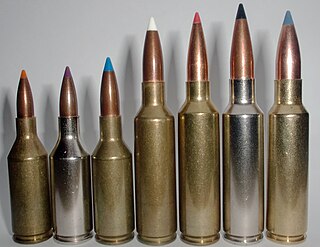
The .325 Winchester Short Magnum, commonly known as the 325 WSM, is an 8mm caliber rebated rim bottlenecked centerfire short magnum medium bore cartridge. The cartridge was introduced by Winchester Ammunition in 2005.

The .284 Winchester is a firearm cartridge, introduced by Winchester in 1963.
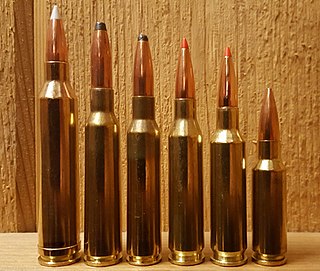
The 6.5mm Creedmoor (6.5×48mm), designated 6.5 Creedmoor by SAAMI, 6.5 Creedmoor by the C.I.P. or 6.5 CM or 6.5 CRDMR for short, is a centerfire rifle cartridge introduced by Hornady in 2007. It was developed by Hornady senior ballistics scientist Dave Emary in partnership with Dennis DeMille, the vice-president of product development at Creedmoor Sports, hence the name. The cartridge is a necked-down modification of the .30 Thompson Center.
The .450 Rigby is a rifle cartridge designed in 1994 by John Rigby & Co. for the hunting of large, thick-skinned dangerous game animals in Africa. The cartridge is based on the .416 Rigby necked up to accept a .458 in (11.6 mm) bullet and is intended for use in magazine rifles. The cartridge should not be confused with .450 Nitro Express which was introduced by Rigby in 1898, and is a rimmed cartridge intended for use in double rifles.

